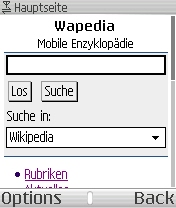Wapedia
Wapedia was a commercial product that adapted the content of the free encyclopedia Wikipedia for mobile devices such as PDAs and cell phones . In contrast to other projects, Wapedia required an internet connection, for example via GPRS or UMTS . Wapedia, founded in 2004 by Florian Amrhein, was operated by Taptu Ltd , based in Cambridge , Great Britain. Wapedia was discontinued in November 2013.
layout
The content of Wikipedia was converted into WML , XHTML MP or, for PDAs, in simple HTML , via its own parser - depending on the capabilities of the end device . The size of the pictures was adapted to the respective screen. Long articles have been broken into smaller sections to accommodate the devices' small screens, memory, and processing power. The displays were supplemented by advertisements.
Technical details
More than 100 Wikipedia language versions were supported, including all those with at least 1000 articles, plus selected others. In addition to the automatic recognition of the device capabilities, the user could change various parameters himself in order to adapt the output to his wishes. For example, the length of the pages or the size of the images could be adjusted.
Update of the articles
All Wikipedia articles were saved in a separate database. These articles were about the regular XML - Dumps updated the Wikipedia database and a few weeks were therefore old.
In addition to this database, which was also important for the own search engine, each time an article was called up, a check was made to see whether there was a more up-to-date version of the article in Wikipedia. This was then displayed and saved in the local database so that subsequent readers of the same article did not have to make a further query to a Wikipedia server. However, if the update failed because e.g. For example, if the server was too slow or did not respond at all, the old locally saved article version was displayed.
This mixture of its own database and proxy-like behavior offered the following advantages:
- The current version of an article was usually displayed.
- If the Wikipedia server failed or if it only responded slowly due to overload, the desired article could still be provided, even if not in a current version.
- Due to the complete inventory of articles, a locally working search engine could be set up in order to be independent of the Wikipedia servers.
- Compared to a simple proxy solution, the Wikipedia servers were significantly less loaded, as an article only had to be requested relatively rarely.
photos
The Wikipedia images were kept in a local cache and scaled for the respective end devices and their display resolutions. In the texts, the images were only displayed as thumbnails in order to keep the data volume, which is often expensive for users, low; however, there was a full screen view for each image.
The first time an image was accessed, it was loaded from the Wikipedia servers, then usually never again.
Search engine
Wapedia maintained its own search engine so that search queries were answered quickly and without being dependent on the Wikipedia servers. The same search technology was used as on Wikipedia: a software based on Apache Lucene .
Editing articles
Wapedia did not allow the editing of articles itself:
- Devices that enable more convenient input usually have a web browser with which you can directly access Wikipedia. Wapedia linked to the edit function of Wikipedia under each article and, if desired, also with each paragraph, so that there was no loss of comfort with such devices. The devices that could not display the editing function of Wikipedia usually only have limited text input options, such as numeric keypad or pen, for which an editing function was rarely useful.
- Many cell phones only accept a limited length of text in HTML forms. If someone were to edit a somewhat longer text or paragraph with such a device and then save it, he could easily have mutilated articles without malicious intent.
- The Wapedia would have worked like an anonymizing proxy during processing, so that vandalism in Wikipedia would have been facilitated.
- In the case of non-anonymous processing, login information would have to be transferred, which could have been a security risk. Many users would not have noticed if their password had been read by a third party.
technology
Four servers were used, each with a web server (Apache). A separate database ( MySQL ) was operated on two of these servers . The servers were independent of one another, as they each had the entire database of articles stored. The databases were synchronized with one another so that both databases were up to date and failures of individual computers did not have any major impact.
Wapedia app
A locally installable app has been available for devices with the Apple iOS and Android operating systems since 2009 . In addition to a paid version, there was a free, advertising-financed version for the end user.
Web links
Individual evidence
- ↑ http://goodbye.wapedia.mobi/wapedia.html ( Memento from November 4, 2013 in the Internet Archive )



